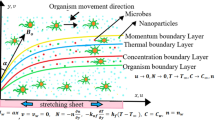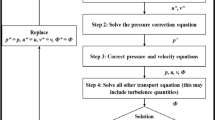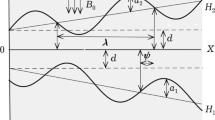Abstract
Blood flow through the composite stenosis of a micro vessel with permeable walls in the presence of an external magnetic field was examined. Endothelial walls of blood vessels are considered to be highly permeable in nature. Thus in the study of such flows, wall permeability must be accounted for. Blood flow made up of a particle-fluid suspension in the core surrounded by a plasma layer was utilized. The effects of introducing as well as increasing wall permeability and the magnetic field were investigated by varying the Darcy number and Hartmann number respectively. Plots were presented to depict the effect of various parameters on the velocity of blood and flow impedance as well as the shear stress on both the vessel wall and at the stenosis throat. The effects of varying hematocrit and peripheral layer thickness were also discussed. These flow characteristics were found to be lower in this model than in its corresponding one layer model. Knowledge gained from this examination of blood flow can aid in understanding and diagnosing cardiovascular diseases in patients especially in cases where a magnetic field is present.
















Similar content being viewed by others
References
Alimohamadi, H., Imani, M., Shojaeizadeh, M.: Non-Newtonian blood flow in a stenosed artery with porous walls in the present of magnetic field effect. Int. J. Technol. Enhanc. Emerg. Eng. Res. 2, 69–75 (2014)
Awgichew, G., Radhakrishnamacharya, G., Shireesha, B.: Effect of slip condition on couple stress fluid flow in a channel with mild stenosis in the presence of uniform magnetic field. Appl. Appl. Math. 9, 54–67 (2014)
Bali, R., Awasthi, U.: Mathematical model of blood flow in small blood vessel in the presence of magnetic field. Appl. Math. 2, 264–269 (2011)
Beavers, G.S., Joseph, D.D.: Boundary conditions at a naturally permeable wall. J. Fluid Mech. 30, 197–207 (1967)
Bugliarello, G., Sevilla, J.: Velocity distribution and other characteristics of steady and pulsatile blood flow in fine glass tubes. Biorheology 7, 85–107 (1970)
Charm, S.E., Kurland, G.S.: Viscosity of human blood for shear rate of 0–100,0000/sec. Nature 206, 617–618 (1965)
Cokelet, G.R., Merrill, E.W., Gilliland, E.R., Shin, H., Britten, A., Wells, R.E.: The rheology of human blood measurement and at zero rate of Shear. J. Rheol. 7, 303–317 (1963)
Eldesoky, I.: Unsteady MHD pulsatile blood flow through porous medium in stenotic channel with slip at permeable walls subjected to time dependent velocity. Walailak J. Sci. Tech. 11, 901–922 (2014)
Ellahi, R., Rahman, S.U., Nadeem, S., Vafai, K.: The blood flow of prandtl fluid through a tapered stenosed arteries in permeable walls with magnetic field. Comm. Theor. Phys. 63, 353–358 (2015)
Joshi, P., Pathak, A., Joshi, B.K.: Two-layered model of blood flow through composite stenosed artery. Appl. Appl. Math. 4, 343–354 (2009)
Hsiao, K.L.: Micropolar nanofluid flow with MHD and viscous dissipation effects towards a stretching sheet with multimedia feature. Int. J. Heat Mass Transf. 112, 983–990 (2017)
Hsiao, K.L.: Stagnation electrical MHD nanofluid mixed convection with slip boundary on a stretching sheet. Appl. Therm. Eng. 98, 850–861 (2016)
Mirza, I.A., Abdulhameed, M., Shafie, S.: Magnetohydrodynamic approach of Non-Newtonian blood flow with magnetic particles in stenosed artery. Appl. Math. Mech. 38, 379–392 (2017)
Nagy, J.A., Benjamin, L., Zeng, H., Dvorak, A.M., Dvorak, H.F.: Vascular permeability. Vasc. Hyper. Angiog. 11, 109–119 (2008)
Ponalagusamy, R.: A two-layered suspension (Particle-fluid) model for non-Newtonian fluid flow in a catheterized arterial stenosis with slip condition at the wall of stenosed artery. Korea-Aust. Rheol. J. 29, 87–100 (2017)
Ponalagusamy, R., Tamil Selvi, R.: Blood flow in stenosed arteries with radially variable viscosity. Periphe. Plasma Layer Thick. Magn. Field, Mecc. 48, 2427–2438 (2013)
Rathee, R., Singh, J.: Analysis of two-layered model of blood flow through composite stenosed artery in porous medium under the effect of magnetic field. J. Rajasthan Acad. Phys. Sci. 12, 259–276 (2013)
Sankar, A., Gunakala, S.R., Comissiong, D.: Two-layered blood flow through a composite stenosis in the presence of a magnetic field. Int. J. Appl. Innov. Eng. Manag. 2, 30–41 (2013a)
Sankar, A., Gunakala, S.R., Comissiong, D.: Two-layered suspension blood flow through a composite stenosis. J. Math. Res. 5, 26–38 (2013b)
Scientific American, Available at: https://www.scientificamerican.com/article/common-prescription-drugs-alter-blood-s-flow/, accessed February 2017
Srinivasacharya, D., Madhava Rao, G.: Computational analysis of magnetic effects on pulsatile flow of couple stress fluid through a Bifurcated artery. Comput. Methods Programs Biomed. 137, 269–279 (2016)
Srivastava, L.M., Srivastava, V.P.: On two-phase model of pulsatile blood flow with entrance effects. Biorheology 20, 761–777 (1983)
Srivastava, N.: Analysis of flow characteristics of the blood flowing through an inclined tapered porous artery with mild stenosis under the influence of an inclined magnetic field. J. Biophys. 2014, 1-9 (2014)
Srivastava, V.P., Saxena, M.: Suspension model for blood flow through stenotic arteries with a cell-free plasma layer. Math. Biosci. 139, 79–102 (1997)
Tam, C.K.W.: The drag on a cloud of spherical particles in low reynolds number flow. J. Fluid Mech. 38, 537–546 (1969)
Thurston, G.B.: Plasma release-cell layering theory for blood flow. Biorheology 26, 199–214 (1989)
Varshney, G., Katiyar, V.K., Kumar, S.: Effect of magnetic field on the blood flow in artery having multiple stenosis: a numerical study. Int. J. Eng. Sci. Technol. 2, 67–82 (2010)
Author information
Authors and Affiliations
Corresponding author
Rights and permissions
About this article
Cite this article
Sankar-Ramkarran, A., Gunakala, S.R. & Comissiong, D. Magnetohydrodynamic Stenosed Blood Flow Through Microcirculation with Permeable Walls. Int. J. Appl. Comput. Math 4, 17 (2018). https://doi.org/10.1007/s40819-017-0432-3
Published:
DOI: https://doi.org/10.1007/s40819-017-0432-3




